Sharks, known for their potent combination of strength and enigma, have captivated humans for ages. Their streamlined shapes, adorned with rows of sharp teeth, reign supreme as top ocean predators. One question that intrigues us is whether they dine during the night. This article will unveil the eating habits of sharks at night, exploring a realm where darkness and predators converge. We’ll also address the question: Do sharks hunt and eat at night? Let’s dive into the captivating world of these creatures and their nighttime feeding behaviors.
What Do Sharks Eat?
Sharks are strong predators with a wide-ranging diet that mirrors their role as top hunters in the sea. Although fish make up a large part of what they eat, sharks are not limited to just fish. They also enjoy various other types of marine life, which shows how adaptable they are and how they’re at the head of the food chain in the ocean.
Sharks are flexible in what they eat, adjusting their diet according to what prey is available. Different types of sharks have specific preferences that match their ecological roles and where they live. While fish of different sizes and species are a major part of what they consume, sharks also have a liking for other types of marine creatures.
Larger sharks sometimes consider marine mammals like seals and sea lions as a meal. Even slow-moving sea turtles become targets for certain sharks. And it doesn’t end there—cephalopods such as squids and even other sharks can also be part of what a shark eats.
Their diet diversifies based on where they live and the demands of their surroundings. Sharks that inhabit shallower waters and coastal areas tend to focus on smaller marine life and schooling fish. On the flip side, those that venture into the deeper parts of the ocean might go after a larger and more elusive prey. This ability to adapt shows how skilled they are at dealing with various challenges in their environment.
Understanding Shark Feeding Behavior
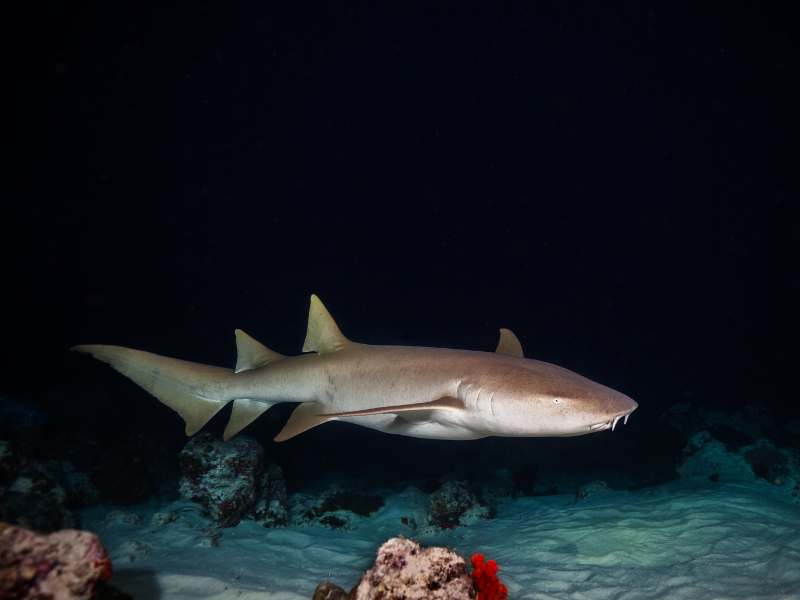
To understand how sharks feed, we need to explore their remarkable habits. Sharks are top predators in the ocean and possess exceptional hunting abilities. They can detect even the faintest sign of potential prey due to their sharp senses. Among these senses, the smelling ability of sharks is particularly outstanding. They can sense the scent of prey from far distances, setting the stage for their planned and strategic hunting methods.
At the top of the ocean food chain, sharks play a crucial role in maintaining the balance of marine ecosystems. Their predatory nature helps keep different species in check within these intricate networks. Exploring their feeding behavior not only reveals their habits but also their significant impact on the environment.
Sharks’ refined senses, developed over millions of years, make them skilled hunters. Their sense of smell is especially impressive. Equipped with specialized receptors in their nostrils, sharks can detect even tiny amounts of chemicals released by potential prey. This heightened sense of smell allows them to follow scent trails and track prey movements across the vast ocean.
Shark-feeding behavior involves more than just instinct; it requires strategic decision-making. Their sharp senses guide their actions, enabling them to assess the size, location, and behavior of potential prey. Once they identify a suitable target, sharks use various hunting techniques.
Some species are known for their quick bursts of speed, which help them close the gap between them and their prey rapidly. Others rely on stealth and camouflage to approach unnoticed, maximizing the element of surprise.
The Nocturnal Nature of Sharks
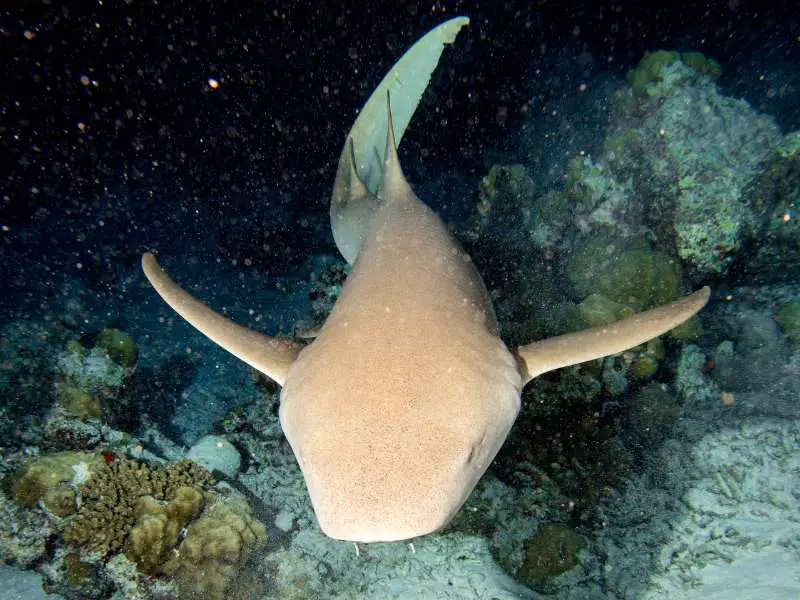
Night, often wrapped in a mystery, calls out to certain shark species. These underwater predators come to life in the dark, venturing into hunting while the world sleeps. The cover of the night offers several benefits: the hidden nature boosts their sneakiness, and the element of surprise is on their side. Diminished visibility helps them get close to prey, ensuring they stay unaware until it’s too late.
As the sun sets, the shift from day to night triggers a big change in the oceans. When the sun goes below the horizon, some sharks wake up from their daytime rest to begin their nighttime pursuits. This adaptation isn’t seen in all shark species, but those that do embrace the night gain specific advantages.
The nighttime behaviors of these sharks match the natural cycle of marine life. These Sharks often target and eat many prey species at night that are more active during the day. This sets up an interesting situation for sharks that have evolved into skilled nighttime hunters. By taking advantage of the unsuspecting prey’s vulnerability in the dark, these sharks gain a significant edge in hunting.
The cover of the night makes them more hidden, enhancing their sneaky approach. The reduced underwater visibility helps their movements, allowing them to get close to potential prey without being noticed. This element of surprise, combined with their specialized sensory adaptations, makes them effective predators even in the deepest parts of the ocean.
Related: Do Sharks Make Sounds?
Factors Influencing Shark Feeding Patterns
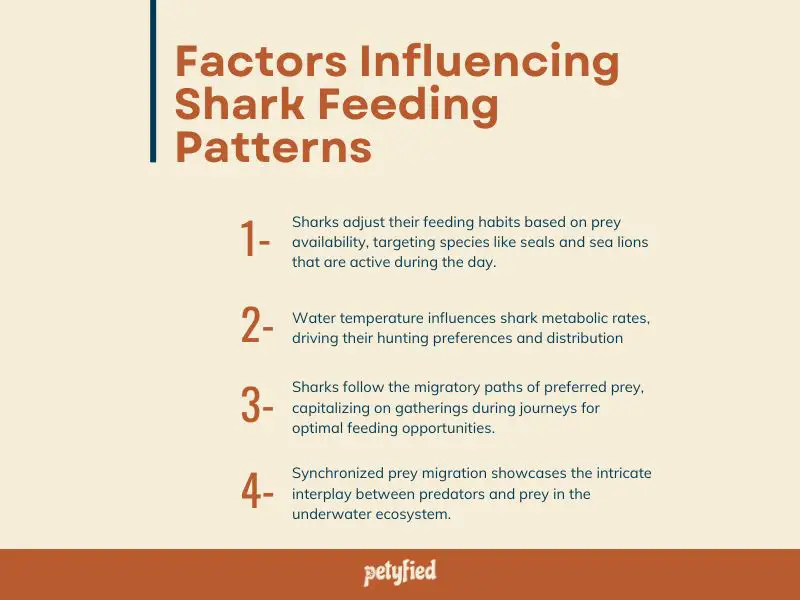
The eating pattern of sharks, including whether they eat at night, is influenced by various factors. The availability of prey plays a crucial role, in guiding their hunting behavior. For example, the great white shark mainly preys on seals and sea lions, creatures that are more active during the day. Additionally, factors such as water temperature, prey migration, and the shark’s physical makeup contribute to their feeding habits.
The great white shark, often highlighted for its impressive hunting skills, demonstrates how prey availability affects shark feeding behavior. These formidable predators target seals and sea lions, creatures that are especially active during the daytime. This aligns their eating patterns with the diurnal habits of their prey, underscoring the important role that prey availability has in determining when sharks feed.
Water temperature is another important aspect that influences sharks’ metabolic rates, distribution, and feeding actions. Different shark species have adapted to specific temperature ranges, impacting where they prefer to hunt and what they prefer to eat. For instance, certain species may be drawn to colder waters, while others may prefer warmer waters. These temperature preferences influence their movements and, as a result, their eating routines.
The migration patterns of prey species also play a significant role in shaping shark feeding behaviors. Sharks often follow the migratory routes of their preferred prey, taking advantage of the gatherings of these organisms during their journeys.
These gatherings provide ample feeding opportunities, shaping when and where sharks engage in feeding frenzies. This synchronized migration highlights the intricate interplay between predator and prey in the underwater world.
Adaptations for Nighttime Feeding
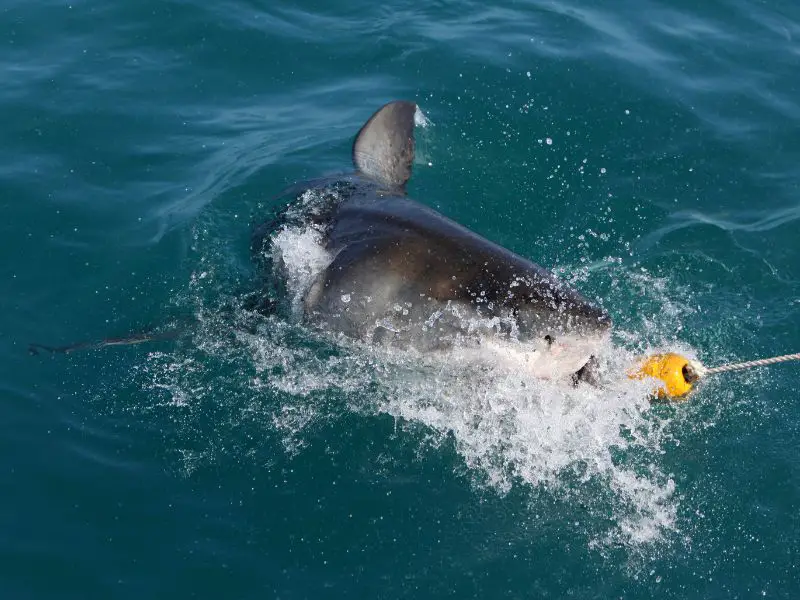
Sharks adapted for nighttime hunting possess specific features that highlight their skill in this activity. Their eye structure stands as a prime example of how they are finely tuned to thrive in poorly lit environments. One of their most notable adjustments is in their ability to see, enabling them to efficiently navigate and hunt in the darkness.
Rod cells in the retinas of nighttime sharks, which often hunt and eat during the night, enhance their vision in low-light settings. These specialized light-sensitive cells allow sharks to capture even the faintest traces of light, giving them a clear advantage when moving through the darkness. This heightened sensitivity provides them with an edge over prey that might not be as well-suited to such conditions.
Adding to their nighttime hunting abilities is the tapetum lucidum, a reflective layer located behind their retinas. This feature, commonly seen in many animals that are active at night, functions like a natural mirror, reflecting light that has already passed through the light-sensitive cells.
This “second chance” at capturing light enhances their visual sharpness, enabling them to effectively track and locate prey even in the darkest ocean depths. These adaptations showcase the intricacy of evolution, demonstrating how nature has shaped these predators for success in the depths of the night.
Examples of Nocturnal Shark Species
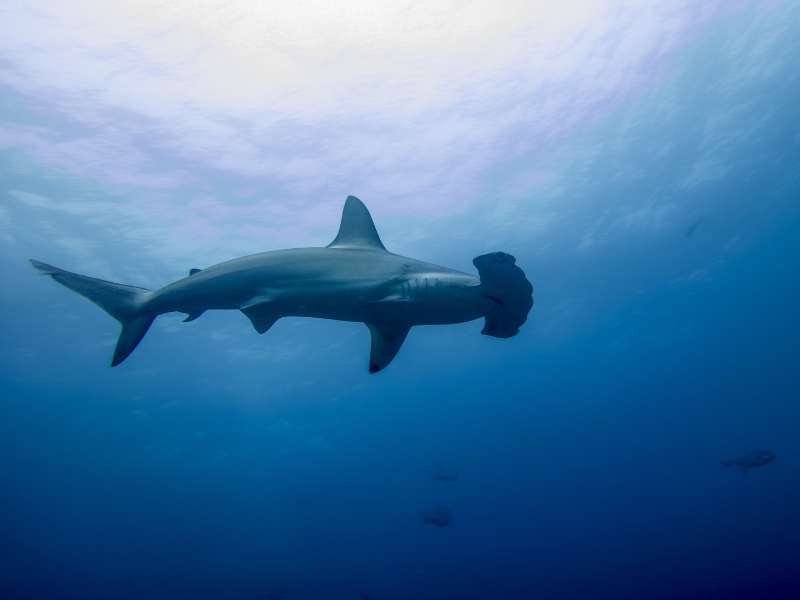
The Theater of Night hosts many types of shark species that prefer the darkness. One of these is the smooth hammerhead shark, a creature with a graceful cephalofoil that makes it stand out. This special head structure works as a streamlined adaptation, helping it move quietly during the night. The smooth hammerhead shark eats a variety of foods such as fish, squid, and crustaceans, showing its ability to find food in the dark.
In the tropical setting, the silvertip shark takes the spotlight. This species shows its skill in nighttime hunting. With distinct silver markings on its top fin and the ends of its side fins, the silvertip shark is a visual wonder on its own. Its nighttime eating habits follow the natural patterns of its environment, where it hunts different sea creatures during the night.
These examples only touch the surface of the various kinds of sharks that eat, participate in the nighttime dance of the oceans, and are active during the night. From the smooth hammerhead’s graceful movements to the striking appearance of the silvertip, each species demonstrates unique changes and actions that have developed to help them survive and succeed in the mysterious world of the night. As these sharks follow the moonlit stage, they add to the complex picture of marine life and remind us of the amazing things that happen in the dark corners of the sea.
Related: Do Sharks Eat Plants?
Hunting Strategies of Night-Feeding Sharks
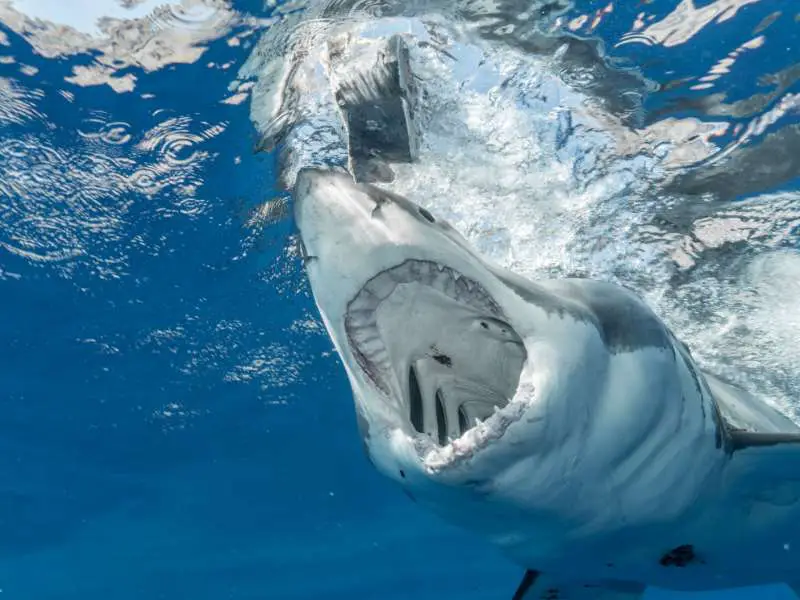
At night, sharks reveal a variety of ways they catch and eat prey, showing their diverse methods for finding food in the dark. The absence of light helps them by making it harder to see and by providing an element of surprise. Two sharks, the tiger shark, and the cookie-cutter shark, have particularly interesting nighttime hunting methods.
The tiger shark uses stealth as a key part of its nighttime hunting technique. This top predator slowly and carefully approaches its prey, staying hidden until the right time to strike. Its dark stripes help it blend into the shadows, and it waits for the perfect moment to attack. This approach lets the tiger shark surprise its prey and improves its chances of a successful catch.
In contrast, the cookie-cutter shark has a unique and strange way of hunting. Despite its small size, this shark is powerful. It leaves round bite marks on larger animals, which look like they were made with a cookie cutter. The cookie-cutter shark is almost like a skilled worker, creating these distinct bites on its prey. This method lets it take small bits of meat without needing a full-scale attack, and it always leaves its mark on larger sea animals.
Nocturnal Feeding: Not Universally Exclusive Among Sharks
The appeal of nighttime feeding is strong for some shark types, but it’s vital to realize that not all sharks follow this pattern. Although many sharks do utilize the dark hours to hunt, not all of them stick solely to nighttime feeding. The realm of shark feeding is diverse, with various behaviors that react to different environmental factors.
The blue shark is a prime example of this adaptability. This species can switch between hunting during the day and at night, showing how biology and the environment intertwine. The blue shark’s feeding depends on cues like water temperature, prey availability, and the presence of competitors. This adaptability highlights the complexity of shark feeding and their interactions in marine ecosystems.
Underwater, each shark species has its own feeding story. From sneaky nighttime hunters to those that navigate the daytime seas, their diverse strategies reflect the range of habitats where these top predators reside. By understanding how and when sharks eat, especially during the night, we gain insight into the intricate dance of life beneath the ocean’s surface.
Shark Feeding Patterns Across Diverse Environments

The way sharks feed varies in different marine settings. Each habitat brings its challenges and chances, affecting when and how sharks eat in their unique ecosystems.
In shallow coastal waters, shark feeding blurs the line between daytime and nighttime. These lively areas are full of various prey, attracting sharks to both daytime and nighttime hunting. With plenty of food around, sharks become opportunistic, grabbing meals whenever they can.
In the deep sea, the symphony of shark feeding takes on a new tune. Bioluminescence lights up the darkness with a magical glow. Sharks in this mysterious world have adapted to thrive in the dark, where nighttime holds its enchanting power.
Enhancements like being sensitive to faint light and having specialized senses help these deep-sea predators navigate, hunt, and communicate effectively, even where traditional sunlight doesn’t reach them.
Related: Do Sharks Eat Pilot Fish?
The Vital Role of Research and Conservation
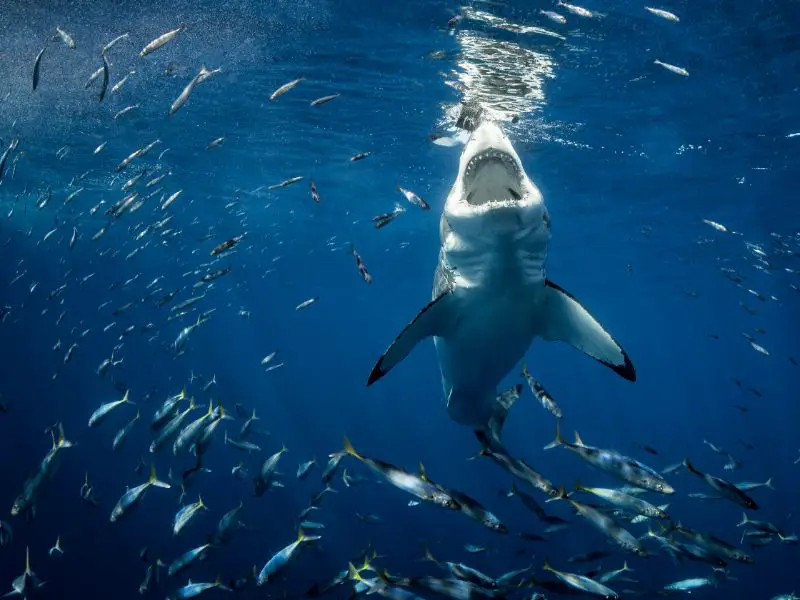
Revealing the patterns of how sharks find food holds deep importance for conservation efforts. Piecing together their eating preferences gives insight into their roles in the ecosystem and the complex interactions they have in the oceans. Armed with this knowledge, targeted conservation strategies can be developed to protect these top predators and maintain the delicate balance of marine ecosystems.
Understanding the shark diet is a crucial aspect of deciphering its impact on marine life. By figuring out what they like to eat and where they fit in the food chain, researchers gain an understanding of the broader ecological dynamics dependent on their presence.
Often at the top of the food chain, sharks have a significant influence on the populations of their prey, shaping the overall health of the ecosystem. This ripple effect highlights their role in upholding biodiversity and ecosystem stability.
Conservation efforts can use this information to create effective plans for safeguarding shark populations. Knowing their eating habits helps determine protected zones, fishing rules, and the preservation of their habitats. By focusing on their dietary needs and behaviors, conservationists contribute to ensuring that sharks remain a crucial force in maintaining the oceans’ health and resilience.
Do Sharks Ever Sleep?
Unlike mammals, sharks have their distinctive way of alternating between rest and vigilance. Their version of sleep doesn’t involve staying still. To survive, they need a continuous flow of water over their gills for breathing. This type of “sleep swimming” lets them rest while staying alert to potential dangers or opportunities.
Sharks are constant travelers of the ocean, and their need for oxygen influences their unusual sleep patterns. While water passes over their gills, they extract oxygen, ensuring their body functions keep running even when they seem to be resting. This exceptional adjustment highlights the delicate balance between the necessity to rest and the importance of staying attentive in their marine environment.
This ongoing state of readiness suits their role as apex predators. The ocean presents countless challenges and chances, requiring flexibility. Sharks’ distinct way of resting showcases their evolutionary strength, allowing them to navigate the seas while never fully letting their guard down. As protectors of the underwater world, sharks remind us of how life has ingeniously adapted to the ocean’s rhythms.
Why Do Sharks Hunt at Night?

Choosing to hunt during the night gives sharks various strategic benefits that align with their instincts and physical traits. Limited visibility underwater at night often means that many prey types are less watchful, providing sharks with an opportunity to approach unnoticed.
Sharks frequently rely on surprise attacks when hunting at night. They can use their heightened sense of smell and specialized vision to detect prey from a distance. As their target gets closer, they accelerate quickly to narrow the distance, catching their prey off guard. This element of surprise significantly increases their hunting success by enhancing their chances of capturing prey that might be more elusive during the day.
Nocturnal hunting is a fitting approach for specific shark species, such as the great white shark. Their nighttime behavior is influenced by their ability to exploit reduced visibility and execute surprise attacks, boosting their chances of finding food. This behavior highlights the remarkable ways in which sharks have evolved to handle the challenges of their environment and establish themselves as skilled and discreet hunters of the ocean.
Do Great White Sharks Hunt at Night?
Among the different shark species, the great white shark emerges as a prime instance of a nighttime predator. While great white sharks are acknowledged for hunting during both day and night, their behavior shifts after sunset. Scientific observations indicate that these top predators become more active during twilight and night hours, exploiting the cover of darkness.
Are Sharks More Active at Night?
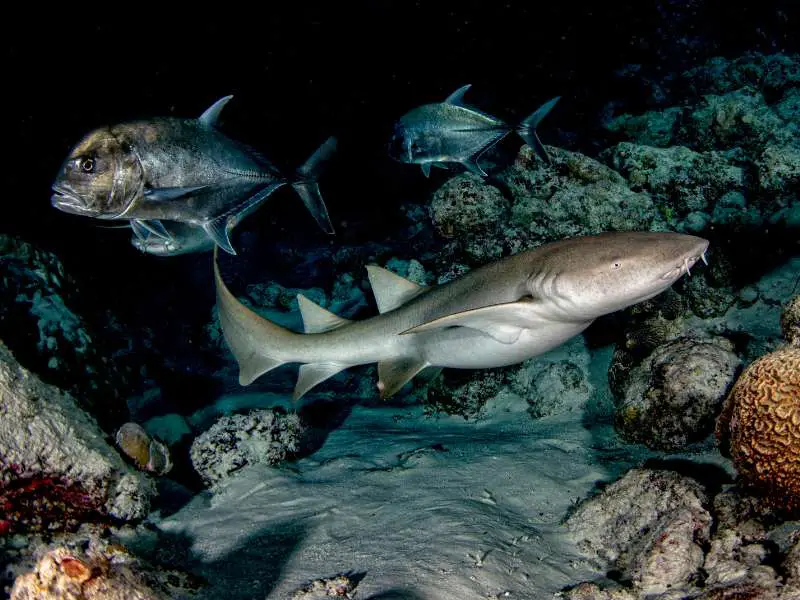
Similar to many other creatures, sharks follow specific activity patterns during the day and night. While some species prefer daylight hours, others thrive in the dark. Sharks become more active at night, positioning them as predators that eat during the night. This behavior is a key part of their natural adaptation to their environment.
The darkness offers sharks numerous benefits that suit their predatory instincts. Reduced visibility becomes an advantage, allowing them to approach prey quietly and adding an element of surprise. Their sharp senses, including enhanced night vision and a keen sense of smell, contribute to their effectiveness as nighttime hunters. These adaptations help them navigate and hunt successfully, even in conditions where other animals might struggle.
Sharks’ nighttime behavior is closely linked to their role as top predators in their ecosystem. Many of their prey species are also more active during the night, creating a balance that has developed over countless years.
By making the most of the darkness, sharks increase their hunting success, showcasing the intricate relationship between predator and prey in the complex web of marine life. As night falls, the oceanic stage transforms, and sharks take the lead in the mysterious drama of the deep sea.
Conclusion
In Conclusion, sharks do eat at night. Many shark species exhibit nocturnal feeding behavior, taking advantage of the cover of darkness to hunt their prey. The reduced visibility and increased stealth offered by the night allow sharks to approach their targets more effectively. Their unique adaptations, including heightened senses and specialized eye structures, enable them to navigate and thrive in the dark oceanic realm. Through their nocturnal quests, sharks contribute to the intricate balance of marine ecosystems, reaffirming their role as apex predators of the underwater world.
FAQs (Frequently Asked Questions)
Yes, many shark species exhibit nocturnal hunting behaviors, taking advantage of the darkness to enhance their stealth and surprise their prey.
Nocturnal feeding is a common behavior among sharks, and they may consume significant amounts of food during their nighttime hunting expeditions.
Nocturnal hours do not inherently render sharks more hazardous to humans compared to daylight hours. The majority of shark-human encounters arise from cases of mistaken identity, where sharks confuse surfers or swimmers with their natural prey. Nonetheless, exercising caution and adhering to local safety guidelines remains paramount when swimming in areas known to host shark populations.
